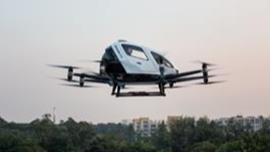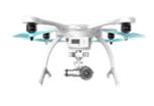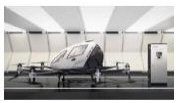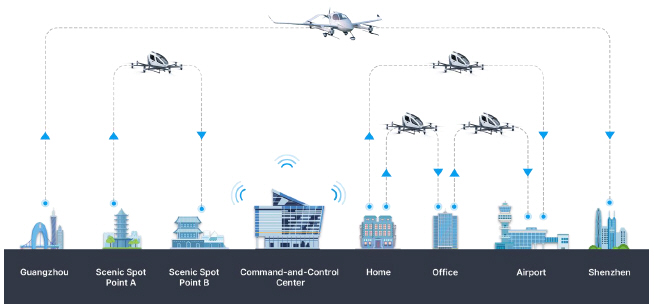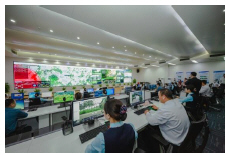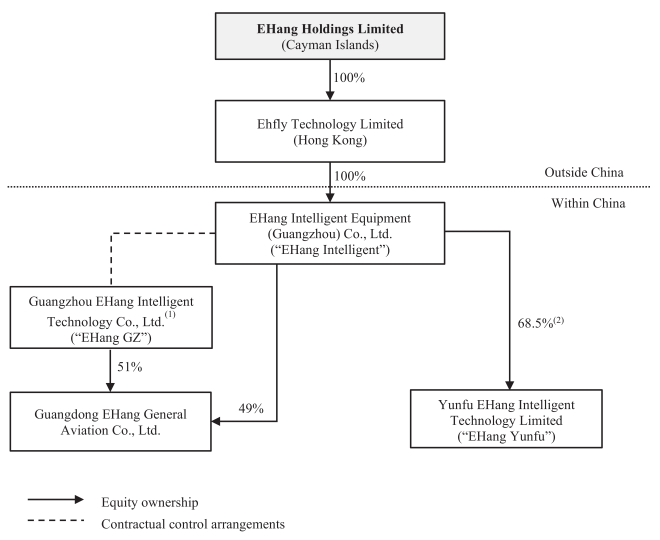The nascent status of the UAV industry is accompanied by a lack of targeted laws and regulations and the relevant legislative and administrative bodies are in the process of laying the first brick for a future regulatory framework governing, among others, the design, manufacturing and the overall airworthiness of UAVs. On January 25, 2019, the CAAC published the UAV Airworthiness Guidance, pursuant to which we are one of the airworthiness assessment pilot programs and would help the CAAC in developing UAV airworthiness standards and assessment rules. According to the UAV Airworthiness Guidance, the UAV airworthiness framework will be based on the assessment, classification and management of operational risks. Operational risks will be categorized into three levels: low, medium and high. UAV operational risks contemplate predominantly the risk of collision in the event of loss of control, including (1) damage resulting from UAV crashes or collisions with any individual or object on the ground;
(2) in-air
collisions, such as with aircrafts or other UAVs; and (3) other risks or damage, such as property losses or any adverse effect on the environment or humans. The UAV Airworthiness Guidance envisages that the UAV airworthiness framework would initially be established in 2019. Detailed rules, procedures and standards relating to the assessment of UAV airworthiness are currently being researched and drafted. For example, On January 20, 2020, the Department of Aircraft Airworthiness Certification of the CAAC issued the
Airworthiness Standards for Fixed-wing Unmanned Aerial Vehicle Systems Used for High-risk Cargo Transportation (Interim)
, which are mainly applicable to fixed-wing unmanned aerial vehicle systems used for feeder cargo transportation under high-risk operating conditions. On August 7, 2019, the CAAC published a discussion draft of the Standards for the Airworthiness of Large Cargo Unmanned Aerial Vehicles, which applies to (a) piston-engined unmanned aerial systems for
non-stunt
flights having a maximum authorized
take-off
weight of 5,500 kg or less; (b) unmanned aerial vehicle systems having a flight altitude of between sea level and 6 kilometers; and (c) other unmanned aerial vehicle systems within limits of movement. On May 11, 2020, the CAAC published the
Standards for the Airworthiness of Medium and High Risk Unmanned Helicopter Systems (Interim)
, mainly targeting conventional unmanned helicopters, including single-rotor with tail paddles, coaxial double rotors, longitudinal double rotors and transverse double rotors. The
Standards for the Airworthiness of Medium and High Risk Unmanned Helicopter Systems (Interim)
sets forth the airworthiness standard for the issuance and modification of the design and production approval for a
mid-range
and high risk unmanned helicopter system, which is applicable to flight operations within and beyond visual line of sight, but excluding personnel transport, flights in icy conditions and stunt shows. On May 26, 2020, the Department of Aircraft Airworthiness Certification of the CAAC issued the Airworthiness Assessment Procedures and the Risk Assessment Guidelines, effective on June 1, 2020, with a
one-year
trial period. According to the Airworthiness Assessment Procedures, enterprises shall apply for the approval letter of design and manufacture from the CAAC if they plan to design and manufacture civil unmanned aerial vehicle systems. The CAAC classifies the risks of civil unmanned aerial vehicle systems into three levels, low, medium and high, and determines the intervention level or inspection frequency based on the risk level of a project. In addition, the CAAC specifies that the holder of an approval letter of design and manufacture shall establish an airworthiness examination department. The airworthiness approval for a private UAV system shall be completed simultaneously with the real-name registration. According to the Risk Assessment Guidelines, risk assessment shall mainly consider two aspects: system risk and product risk. On October 29, 2021, CAAC further published
Unmanned Aircraft System Airworthiness Certification Management Procedures (Draft for Comments),
Civil Unmanned Aircraft System Safety Analysis Guidelines (Draft for Comment), and Civil Unmanned Aircraft Registration Management Procedures (Draft for Comment)
, or collectively Draft UAV Rules. Such Draft UAV Rules mainly cover related activities of design, production and airworthiness approval related to certain medium UAVs weigh between 25 kilograms and 150 kilograms, and large UAVs exceed 150 kilograms in weight.
The trial flights of our passenger-grade AAVs were supported with approval obtained from the Department of Aircraft Airworthiness Certification of the CAAC based on the UAV Airworthiness Guidance. The approval, which expired on December 31, 2019, allowed us to conduct trial flights to collect the relevant supporting data. The EHang 216 Type Certification programs of the CAAC are ongoing. As the only passenger-grade AAV pilot company approved by the CAAC in China, we continue to conduct AAV flights to accumulate more trial data and experience. We submitted an application for EHang 216 Type Certification to CAAC in December 2020, which was accepted by CAAC in January 2021. In April 2021, the Central South Regional Administration of CAAC, convened the first meeting of Type Certification programs for our passenger-grade AAVs. In February 2022, the CAAC formally adopted the Special Conditions for EHang 216 Type Certification. We made critical contributions of our technological expertise and
know-how.
The Special Conditions provided clear safety requirements for the certification of EHang 216, including flight performance, aircraft structures, design and constructions, propulsion systems, systems and equipment, data link, ground control station, etc. With specified requirements set out, we have progressed to the compliance review phase and submitted to the CAAC the Project Specific Certification Plan and the Certification Plan with solid means of compliance.
According to the
Guideline for the Standardization of UAV Systems (2017 to 2018)
jointly issued by the National Standardization Administration, the Ministry of Science and Technology, the Ministry of Industry and Information Technology, or the MIIT, the Ministry of Public Security, the Ministry of Agriculture (currently known as the Ministry of Agriculture and Rural Affairs), the General Administration of Sport, the National Energy Administration and the CAAC on June 13, 2017, the development of
non-military
use UAV systems standard will be staggered into two phases. In the first phase, from 2017 to 2018, the focus is on answering market demand for UAV systems, providing support to industry-wise supervision, and initiating the development of standards for UAV systems. The second phase, from 2019 to 2020, envisions an incremental development of more than 300 UAV system standards. A range of standards in the regulatory pipeline under this guideline, includes safety standards, research and development standards and operational standards, as well as standards for systems, infrastructure, subassemblies and components of
non-military
use UAV.

